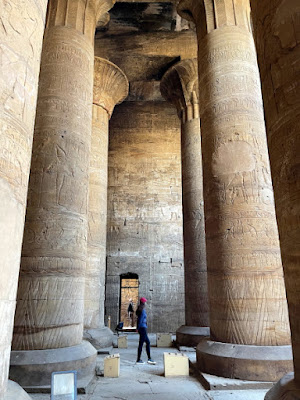 |
| Picture by Heather |
While our boat was docked in Edeu, we were up early in the morning so that we could ride in horse-drawn carriages (called "caleches") to the Temple of Horus and then make it back to the boat before it departed.
The Temple of Horus is one of the most intact temples in Egypt because it was buried under the desert sand for centuries. Unfortunately, many of the pharaohs and gods were defaced by early Christians and the ceilings were blackened when they tried to burn the "pagan depictions." The god Horus is depicted with a man's body and a falcon's head.
 |
| Picture by Kolohe |
 |
| Picture by Kolohe |
 |
| Picture by Kolohe |
 |
| Picture by Kolohe |
 |
| Picture by Unknown Photographer |
 |
| Picture by Heather |
Our guide told us about the hill adjacent to the temple; but it was too early in the morning and I do not remember the hill's significance, or why there were holes in a wall on the property.
 |
| Picture by Heather |
Before entering the temple grounds there were a series of entrepreneurs that were selling all types of souvenirs. One of the men even put a turban on my head to wear while visiting the site. They also put a turban on Lynsay's head. When the sales person asked me what my name was, I said "Bob." He then asked what Lynsay's name was and I said "Brenda." Lynsay could not understand why all of the sales people kept calling me "Bob" and her "Brenda," so I had to explain that I did not want go give out our real names. For the rest of the day, I was "Bob" and Lyndsay was "Brenda." Of course, the sales person wanted us to purchase the turbans before we left for our riverboat.
 |
| Picture by Kolohe |
 |
| Picture by Heather |
 |
| Picture by Heather |
 |
| Picture by Kolohe |
The wall carvings tell the story of how Horus defeated the god Set, who killed Horus's father Osiris. This is one of the few places in Egypt where this story is illustrated.
 |
| Picture by Kolohe |
 |
| Picture by Kolohe |
A pair of granite statures featuring Horus as a falcon stand in front of the 120-foot tall pylons.
 |
| Picture by "Rocky" on Heather's Camera |
 |
| Picture by Heather |
The inner rooms of the temple are dark and originally illuminated only by light from narrow slits in the ceiling. However, for the benefit of visitors, most of the rooms are now lit by lights along the floor.
In the sanctuary there is a barque replica, the sacred boat used to transport a statue of Horus for festivals.
 |
| Picture by Kolohe |
From the Court of Offerings, there are stairs lead to the terrace and then to the Court of Mysteries that extends around the sanctuary. We were not allowed up the stairs, but we were told that there are ten rooms, each with specific characteristics, that open off of the Court of Mysteries.
On the ground level there are extensive wall carvings on the temple walls. The God Anubis is featured with the body of a human and the head of a jackal. Ra is also featured. He was the most important deity and is featured as a human body with a sun over a falcon's head.
 |
| Picture by Kolohe |
 |
| Picture by Heather |
 |
| Picture by Kolohe |
 |
| Picture by Heather |
 |
| Picture by Heather |
 |
| Picture by Kolohe |
A library was once located in Hypostyle Hall and the walls still contain names of the library books. There are also recipes and the ingredients used for making perfumes and essences that were part of temple rituals.
Recorded on a wall is the date that construction started on the temple - August 23, 237 BC.




















































No comments:
Post a Comment